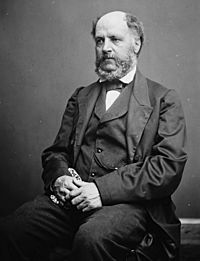Charles Benedict Calvert facts for kids
Quick facts for kids
Charles Benedict Calvert
|
|
|---|---|
 |
|
| Member of the U.S. House of Representatives from Maryland's 6th district |
|
| In office June 1861 – November 1863 |
|
| Preceded by | George Wurtz Hughes |
| Succeeded by | District abolished |
| Member of the Maryland House of Delegates | |
| In office 1839–1846 |
|
| Personal details | |
| Born | August 23, 1808 Riversdale, Maryland, U.S. |
| Died | May 12, 1864 (aged 55) Riverdale Park, Maryland, U.S. |
| Resting place | Calvert Cemetery |
| Political party | Democratic (1839–1860) Unionist (1861–1863) |
| Parents | George Calvert Rosalie Stier Calvert |
| Alma mater | University of Virginia |
| Profession | Businessman, landowner |
Charles Benedict Calvert (born August 23, 1808 – died May 12, 1864) was an important American politician. He served as a U.S. Representative for Maryland from 1861 to 1863. Calvert was a big supporter of the people who invented the telegraph, a device that sent messages over long distances.
In 1856, he founded the Maryland Agricultural College. This was the first college in America focused on agricultural research. Today, it is known as the University of Maryland. Charles Benedict Calvert was also a direct descendant of the Lords Baltimore. These were the original governors of the Province of Maryland from 1631 to 1776.
Contents
Early Life and Family
Charles Benedict Calvert was born on August 23, 1808. His family's home was a large estate called Riversdale in Maryland.
His mother was Rosalie Eugenia Stier. She came from a wealthy family in Europe. Her parents had moved to America when French armies took over their hometown of Antwerp. Calvert's father was George Calvert, a rich landowner. George Calvert's father, Benedict Swingate Calvert, was the natural son of Charles Calvert, the fifth Lord Baltimore.
Education and Learning
Calvert completed his early studies at Bladensburg Academy in Maryland. Later, he attended the University of Virginia in Charlottesville. He received a certificate of completion from the university in 1827. Even though he didn't attend all the time, he was very interested in farming and raising animals.
Science and Farming Innovations
Calvert inherited the Riverdale plantation from his family. He brought many new ideas to farming there. He used scientific methods and learned from farming journals and newspapers. He also showed his new ideas at county and state fairs. He even created some of his own farming inventions. He was able to try out these new ideas because he managed a large estate with many workers.
Calvert was a strong supporter of the inventors of the telegraph, Samuel Morse and Alfred Vail. On April 9, 1844, Morse and Vail successfully tested their new device. They sent a message from Washington, D.C., to Calvert's home at Riversdale. This important test happened before the more famous message, "What hath God wrought?" was sent from Washington to Baltimore.
Calvert became the president of the agricultural societies for Prince George's County, Maryland and the entire state of Maryland. He also served as a vice president for the United States Pomological Society, which studies fruits. In 1856, he founded the first agricultural research college in America. This college is now known as the University of Maryland, College Park. Calvert also pushed for the creation of the United States Department of Agriculture.
Political Career
Calvert served as a member of the Maryland House of Delegates in 1839, 1843, and 1844. He was elected to the U.S. Congress as a Unionist. He represented Maryland's Sixth Congressional District. This election took place on June 13, 1861.
In the election of November 4, 1863, he tried to be re-elected. He ran as a Conditional (Conservative) Unionist candidate in the Fifth Congressional District. However, he was not successful. After leaving office, he went back to his farming work. He passed away on May 12, 1864, at Riversdale. He is buried in Calvert Cemetery.


